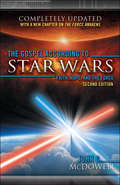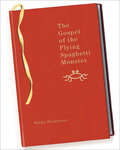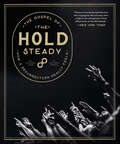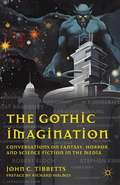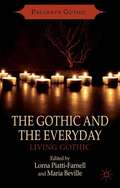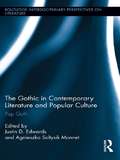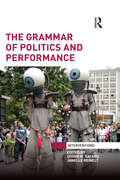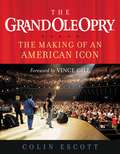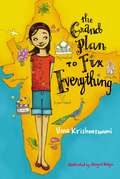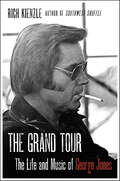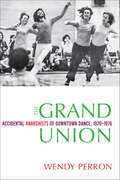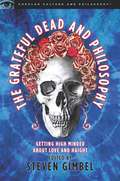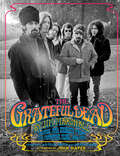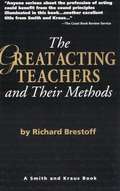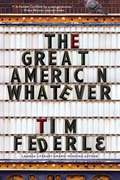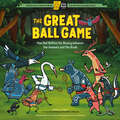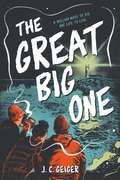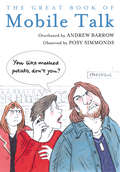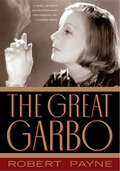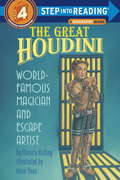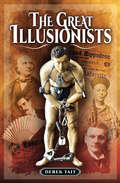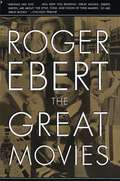- Table View
- List View
The Gospel according to Star Wars: Faith, Hope, And The Force
by John C. McDowellIn a new and updated version of this best-selling book, John McDowell explores the many spiritual themes that weave throughout the Star Wars films. From the Force to the dark side, the issues discussed in the films have a moral and spiritual complexity that, if paid attention to, can help us better understand our place in the world and our relation to others and to God. George Lucas, the creator of Star Wars, did not intend for his films to be mere entertainment, McDowell argues. Rather, he hoped his films would be used as a vehicle for moral education. <P><P>This new version has been thoroughly revised to include discussion of The Force Awakens and other new developments in the Star Wars universe.
The Gospel of the Flying Spaghetti Monster
by Bobby HendersonCAN I GET A "RAMEN" FROM THE CONGREGATION?! Behold the Church of the Flying Spaghetti Monster (FSM), today's fastest growing carbohydrate-based religion. According to church founder Bobby Henderson, the universe and all life within it were created by a mystical and divine being: the Flying Spaghetti Monster. What drives the FSM's devout followers, a. k. a. Pastafarians? Some say it's the assuring touch from the FSM's "noodly appendage. " Then there are those who love the worship service, which is conducted in pirate talk and attended by congregants in dashing buccaneer garb. Still others are drawn to the Church's flimsy moral standards, religious holidays every Friday, or the fact that Pastafarian heaven is way cooler: Does your heaven have a Stripper Factory and a Beer Volcano? Intelligent Design has finally met its match-and it has nothing to do with apes or the Olive Garden of Eden. Within these pages, Bobby Henderson outlines the true facts- dispelling such malicious myths as evolution ("only a theory"), science ("only a lot of theories"), and whether we're really descended from apes (fact: Humans share 95 percent of their DNA with chimpanzees, but they share 99. 9 percent with pirates!) See what impressively credentialed top scientists have to say: "If Intelligent Design is taught in schools, equal time should be given to the FSM theory and the non-FSM theory. " -Professor Douglas Shaw, Ph. D. "Do not be hypocritical. Allow equal time for other alternative 'theories' like FSMism, which is by far the tastier choice. " -J. Simon, Ph. D. "In my scientific opinion, when comparing the two theories, FSM theory seems to be more valid than classic ID theory. " -Afshin Beheshti, Ph. D. Read the book and decide for yourself!
The Gospel of the Hold Steady: How a Resurrection Really Feels
by Michael Hann The Hold SteadyAn oral history (with photographs) of the greatest American bar band of the twenty-first century."Plenty of rock bands treat their fans like congregants. But, not many shine a light on the arrangement. Fewer still go as far as The Hold Steady, whose lead vocalist and lyricist, Craig Finn, has a disarming way of combining humility and exultation." —New York TimesOn January 22, 2003, four men stepped onto a stage in Brooklyn and did something no one else was doing at that time, in that place. They played rock ’n’ roll: old-fashioned rock ’n’ roll with skyscraping riffs and sloppy solos, topped with extraordinary lyrics about an out-of-focus America, blurred by pills and powders, of crime and fear and desperation and redemption.Twenty years later, The Hold Steady are one of America’s most beloved rock bands, famed for live shows that turn unbelievers into converts, and for a catalog filled with some of the most exciting yet poetic music of the twenty-first century. To mark those twenty years, The Hold Steady tell their full story in The Gospel of The Hold Steady: How a Resurrection Really Feels. An oral history, based on interviews with everyone who has played in the band, and those who have worked with them over the course of their career, The Gospel of the Hold Steady addresses all the triumphs and setbacks of The Hold Steady’s career in the band’s own words—from high times to near deaths, from the brink of splitting to their current renaissance. The volume also includes over 200 photographs and images.The Gospel of The Hold Steady is completed by essays about America’s greatest bar band by writers Rob Sheffield, Laura Barton, Isaac Fitzgerald, and Michael Hann, as well as the thoughts and memories of “The Unified Scene”—the fans who have helped define the band’s identity over the years. This is a book for everyone who loves The Hold Steady, and anyone who understands that the magic of rock ’n’ roll happens on a stage in a small room, with voices raised from the crowd.
The Gothic Imagination
by John C. TibbettsThis book brings together the author's interviews with many prominent figures in fantasy, horror, and science fiction to examine the traditions and extensions of the gothic mode of storytelling over the last 200 years and its contemporary influence on film and media.
The Gothic and the Everyday: Living Gothic (The Palgrave Gothic Series)
by Gill PartingtonThe Gothic and the Everyday aims to regenerate interest in the Gothic within the experiential contexts of history, folklore, and tradition. By using the term 'living', this book recalls a collection of experiences that constructs the everyday in its social, cultural, and imaginary incarnations
The Gothic in Contemporary Literature and Popular Culture: Pop Goth (Routledge Interdisciplinary Perspectives on Literature)
by Justin D. Edwards Agnieszka Soltysik MonnetThis interdisciplinary collection brings together world leaders in Gothic Studies, offering dynamic new readings on popular Gothic cultural productions from the last decade. Topics covered include, but are not limited to: contemporary High Street Goth/ic fashion, Gothic performance and art festivals, Gothic popular fiction from Twilight to Shadow of the Wind, Goth/ic popular music, Goth/ic on TV and film, new trends like Steampunk, well-known icons Batman and Lady Gaga, and theorizations of popular Gothic monsters (from zombies and vampires to werewolves and ghosts) in an age of terror/ism.
The Grammar of Politics and Performance (Interventions)
by Janelle Reinelt Shirin M RaiThis volume brings together important work at the intersection of politics and performance studies. While the languages of theatre and performance have long been deployed by other disciplines, these are seldom deployed seriously and pursued systematically to discover the actual nature of the relationship between performance as a set of behavioural practices and the forms and the transactions of these other disciplines. This book investigates the structural similarities and features of politics and performance, which are referred to here as ‘grammar’, a concept which also emphasizes the common communicational base or language of these fields. In each of the chapters included in this collection, key processes of both politics and performance are identified and analyzed, demonstrating the critical and indivisible links between the fields. The book also underlines that neither politics nor performance can take place without actors who perform and spectators who receive, evaluate and react to these actions. At the heart of the project is the ambition to bring about a paradigm change, such that politics cannot be analyzed seriously without a sophisticated understanding of its performance. All the chapters here display a concrete set of events, practices, and contexts within which politics and performance are inseparable elements. This work will be of great interest to students and scholars in both International Relations and Performance Studies.
The Grand Ole Opry: The Making of An American Icon
by Colin EscottThe official inside history of the home of country music--the Grand Ole Opry.This is the story of the birthplace of country music as told by the people who were there--from the birth of country music 100 years ago to the songs and culture its myriad fans know and love today. Nearly every country music icon has crossed the Grand Ole Opry stage, including Hank Williams, Johnny Cash, Dolly Parton, Reba McEntire, Garth Brooks, and recent inductee Dierks Bentley. Drawing from detailed archives of correspondence, photographs, oral histories, and live recordings (few of which have been made public until now), this history offers fans an exclusive look into the heart and soul of country music.
The Grand Plan to Fix Everything
by Uma Krishnaswami Abigail HalpinEleven-year old Dini loves movies--watching them, reading about them, trying to write her own--especially Bollywood movies. But when her mother tells her some big news, it does not at all jive with the script of her life she has in mind. Her family is moving to India...and, not even to Bombay, which is the center of the Bollywood universe and home to Dini's all-time most favorite star, Dolly. No, Dini is moving to a teeny, tiny village she can't even find on a map. Swapnagiri. It means Dream Mountain and it only looks like a word that's hard to pronounce. But to that open-minded person who sounds the name out, one letter at a time, it falls quite handily into place: S-w-a-p-n-a-g-i-r-i. An honest sort of name, with no surprise letters waiting to leap out and ambush the unwary. That doesn't mean there aren't surprises in Swapnagiri like mischievous monkeys and a girl who chirps like a bird--and the biggest surprise of all: Dolly. So now, Dini is hard at work on a new script, the script in which she gets to meet the amazing Dolly. But, life is often more unpredictable than the movies and when Dini starts plotting her story things get a little out of control. This is a joyful, lively Bollywood inspired story is full of colorful details, delicious confections and the wondrous, magical powers of coincidence. Uma Krisnaswami will have you smiling from ear to ear.
The Grand Plan to Fix Everything
by Uma Krishnaswami Abigail HalpinRose petal milk shakes and a world of surprises awaits Dini when her family moves to India in this spirited novel with Bollywood flair. <p><p> Eleven-year old Dini loves movies--watching them, reading about them, trying to write her own--especially those oh-so-fabulous Bollywood movies where you don't need to know the language to get what's going on. But when her mother reveals some big news, it does not at all jibe with the script Dini had in mind. Her family is moving to India. And not even to Bombay, which is the "center of the filmi universe" (and home to Dini's all-time most favorite star, Dolly Singh). No, they're moving to a teeny, tiny town that she can't even find on a map: Swapnagiri. It means Dream Mountain, a sleepy little place where nothing interesting can happen.... <p> But wait a movie minute! Swapnagiri is full of surprises like rose petal milk shakes, mischievous monkeys, a girl who chirps like a bird, and...could it be...Dolly herself?
The Grand Tour: The Life and Music of George Jones
by Rich KienzleIn the vein of the classic Johnny Cash: The Life, this groundbreaking work explores the wild life and extraordinary musical career of “the definitive country singer of the last half century” (New York Times), who influenced, among others, Bob Dylan, Buck Owens, Emmylou Harris, John Fogerty, George Strait, Alan Jackson, and Garth Brooks.In a masterful biography laden with new revelations, veteran country music journalist/historian Rich Kienzle offers a definitive, full-bodied portrait of legendary country singer George Jones and the music that remains his legacy. Kienzle meticulously sifted through archival material, government records, recollections by colleagues and admirers, interviewing many involved in Jones’s life and career. The result: an evocative portrait of this enormously gifted, tragically tormented icon called “the Keith Richards of country.”Kienzle chronicles Jones’s impoverished East Texas childhood as the youngest son of a deeply religious mother and alcoholic, often-abusive father. He examines his three troubled marriages including his union with superstar Tammy Wynette and looks unsparingly at Jones’s demons. Alcohol and later cocaine nearly killed him until fourth wife Nancy helped him learn to love himself. Kienzle also details Jones’s remarkable musical journey from singing in violent Texas honky tonks to Grand Ole Opry star, hitmaker and master vocalist whose raw, emotionally powerful delivery remains the Gold Standard for country singers.The George Jones of this heartfelt biography lived hard before finding contentment until he died at eighty-one—a story filled with whiskey, women and drugs but always the saving grace of music.Illustrated with eight pages of photos.
The Grand Union: Accidental Anarchists of Downtown Dance, 1970–1976
by Wendy PerronThe Grand Union was a leaderless improvisation group in SoHo in the 1970s that included people who became some of the biggest names in postmodern dance: Yvonne Rainer, Trisha Brown, Steve Paxton, Barbara Dilley, David Gordon, and Douglas Dunn. Together they unleashed a range of improvised forms from peaceful movement explorations to wildly imaginative collective fantasies. This book delves into the "collective genius" of Grand Union and explores their process of deep play. Drawing on hours of archival videotapes, Wendy Perron seeks to understand the ebb and flow of the performances. Includes 65 photographs.
The Grateful Dead and Philosophy: Getting High-Minded about Love and Haight
by Steven GimbelTwenty philosophical essays about the Grateful Dead phenomenon evaluates the band, its lyrics, and its influence from a variety of ancient and modern perspectives to consider how it fits into broader trends of American thought.
The Grateful Dead by Jim Marshall: Photos and Stories from the Formative Years, 1966–1977
by Jim Marshall David Gans Amelia DavisOne of the greatest bands of all time and one of the greatest music photographers in history meet in this incredible visual archive featuring exclusive never-before-seen photos.Jim Marshall took over ten thousand photos of the Grateful Dead throughout their career—from Woodstock to the last free concert on Haight Street and beyond. Marshall’s magnificent images chronicle the band’s trajectory as hairstyles changed, relationships came and went, and the music evolved into the sound that would become beloved by generations to come. Marshall’s instinctive eye matched the Dead’s improvisational style, and he was welcomed into its family as he immersed himself in San Francisco’s counterculture scene throughout the 1960s and ’70s. He documented casual domestic scenes and transcendent concerts alike, offering a nuanced and intimate portrait of the band. The striking images in this book—a third of which have never been published—are printed in the rich, high-contrast tones that Marshall favored. They include glimpses of remarkable moments like the Newport Pop Festival, Woodstock, and the Human Be-In. Quotes from contemporaries, collaborators, and members of the wider Dead community bring the images alive, while longer essays contextualize this photographic archive. Whether you were there from the beginning or wish you had been, this is your chance to see a glorious era of music history as you’ve never seen it before, through the eyes of a visionary artist.PHOTOGRAPHY ICON: Jim Marshall is the great rock-and-roll photographer, as his images of the Grateful Dead prove. In addition to being a legendary artist, he was a peer, colleague, and friend to the musicians and documented countless iconic musical moments throughout the 1960s and 1970s. NEVER-BEFORE-SEEN IMAGES: From electrifying photos of the band playing live onstage to more intimate portraits of rehearsals, this collection showcases an amazing array of images. One-third of the photos have never before been published, making The Grateful Dead by Jim Marshall an exclusive treat for any Deadhead or photography fan. THE ULTIMATE DEADHEAD COLLECTIBLE: Many books and documentary films have been created about the Grateful Dead, but Marshall's photographs offer an unmatched time capsule of the Dead and their era. Published to coincide with the band's 60th anniversary, this book is a perfect gift for anyone who's interested in music history or nostalgic for the counterculture of the ’60s and ’70s.Perfect for: Fans and followers of the Grateful Dead, Jerry Garcia, and Dead & Company Jim Marshall fans Classic rock devotees and musicians Photographers and photography book collectors Holiday shoppers looking for a great present for music lovers Birthday or any special occasion gift-giving to any devoted fan of the Dead and iconic American rock bands
The Great Acting Teachers and Their Methods
by Richard BrestoffIt is vital for actors to understand how their craft evolved and in what tradition they stand. A global understanding of the past and present orients one better towards the future. It is important to know that realism in acting came as a reaction to the falseness that had gone before. Knowing this, one can anticipate that realism too will be overthrown in its turn. For example, in many private studios and at universities today, body training and mask work is in the ascendancy. Making one's way through the maze of actor training is a daunting task. This book is designed to help you understand the most important ideas about acting, where they came from, and how they are used in training programs today. With this knowledge, you will be prepared to make wise choices about your own path through this rewarding, frustrating, astonishing art.
The Great American Recipe Cookbook: Regional Cuisine and Family Favorites from the Hit TV Show
by The Great American RecipeThis beautiful cookbook showcases the best of American regional cooking from the cooks and judges featured in PBS&’ The Great American Recipe In the first season of The Great American Recipe, 10 home chefs representing distinct culinary backgrounds brought with them a rich collection of recipes. Some were secret family recipes passed down through the generations, some were new twists on regional classics, and others were their own deeply personal recipes crafted with love . . . and, together, they represent the dynamic story of America told through the diversity of its food. Now, you can bring all the fun of this new series to your kitchen with more than 100 delicious, easy-to-follow recipes from the cast, host, and judges. These recipes are accessible and taste like home—evoking nostalgia while inspiring you to explore new flavors with your loved ones. Inside, you&’ll find new staples and rediscover family favorites, such as: Southern Smoke Mac and Cheese Red Chilaquiles Rhode Island–Style Fried Calamari Shakshuka with Chive Flatbread Chicken and Waffle Sandwiches Pizza Calabrese L&’Italiano Burgers Crowd-Pleaser Tostadas Korean-Style Meatloaf and Potatoes Cast Iron Ribeye with Blue Cheese and Balsamic Steak Sauce Cranberry White Chocolate Oatmeal Cookies with Sour Cream Frosting Cannoli Dip Packed with amazing dishes and warm personal stories, and illustrated with gorgeous food photography and stills from the series, The Great American Recipe Cookbook is a must-have for fans of the show, food lovers, and every person who believes that food tells the story of who we are.
The Great American Whatever
by Tim Federle<p>From the award-winning author of <i>Five, Six, Seven, Nate!</i> and <i>Better Nate Than Ever</i> comes "a Holden Caulfield for a new generation" (Kirkus Reviews, starred review). <p>Quinn Roberts is a sixteen-year-old smart aleck and Hollywood hopeful whose only worry used to be writing convincing dialogue for the movies he made with his sister Annabeth. Of course, that was all before--before Quinn stopped going to school, before his mom started sleeping on the sofa...and before the car accident that changed everything. <p>Enter: Geoff, Quinn's best friend who insists it's time that Quinn came out--at least from hibernation. One haircut later, Geoff drags Quinn to his first college party, where instead of nursing his pain, he meets a guy--okay, a hot guy--and falls, hard. What follows is an upside-down week in which Quinn begins imagining his future as a screenplay that might actually have a happily-ever-after ending--if, that is, he can finally step back into the starring role of his own life story.
The Great Ball Game: How Bat Settles the Rivalry between the Animals and the Birds; A Circle Round Book (Circle Round)
by Rebecca SheirA classic folktale with roots in the traditional stories of many Indigenous peoples in North America, The Great Ball Game is adapted for today's kids by Rebecca Sheir, host of the award-winning Circle Round podcast. The stunning art of Joshua Mangeshig Pawis-Steckley, an Ojibwe woodland artist, along with creative activities, make this an engaging picture book that also fosters storytelling and promotes the values of diversity, acceptance, and understanding of others.
The Great Big One
by J. C. GeigerWith natural disasters and nuclear war threatening their small town, two twin brothers find themselves enraptured by mysterious music that could change the course of their lives.Everyone in Clade City knows their days are numbered. The Great Cascadia Earthquake will destroy their hometown and reshape the entire West Coast—if they survive long enough to see it. Nuclear war is increasingly likely. Wildfires. Or another pandemic. To Griff, the daily forecast feels partly cloudy with a chance of apocalyptic horsemen.Griff&’s brother, Leo, and the Lost Coast Preppers claim to be ready. They&’ve got a radio station. Luminous underwater monitors. A sweet bunker, and an unsettling plan for &“disaster-ready rodents.&” But Griff&’s more concerned about what he can do before the end times. He&’d like to play in a band, for one. Hopefully with Charity Simms. Her singing could make the whole world stop.When Griff, Leo, and Charity stumble upon a mysterious late-night broadcast, one song changes everything. It&’s the best band they&’ve ever heard—on a radio signal even the Preppers can&’t trace. They vow to find the music, but aren&’t prepared for where their search will take them. Or for what they&’ll risk, when survival means finding the one thing you cannot live without.
The Great Book of Mobile Talk: You Like Mashed Potato, Don’t you?
by Andrew BarrowOverheard mobile pronouncements are a modern phenomenon. In the street, in the park, in supermarkets, buses, waiting rooms and even, heaven help us, in libraries, it’s quite impossible to get away from these tasty or repellent fragments of other people’s private lives. Wherever you lurk, their outbursts of despair or irritation ring out: mega-tantrums, in-jokes, celebrity spottings, instant post-mortems, office politics, whoops of joy and anger, weather reports, devilishly dull domestic details, parental problems, health issues, holiday plans, money matters, dinner menus, ultimatums, gossip, sporting news, amorous overtures, business deals – and any number of time-wasting pleasantries.From the stunningly mundane to the shockingly direct, the sublime to the ridiculous, here is a brilliantly curated collection of overheard mobile conversational gems.
The Great Garbo
by Robert PayneThis lavishly-illustrated tour through the film career of Greta Garbo (1905-1990) provides a biographical background of the star and an analysis of her very special mystique. Payne describes how Garbo's timeless beauty worked its magic in such films as Flesh and the Devil, Anna Christie, Mata Hari, Grand Hotel, Queen Christina, Camille, and Ninotchka. Remarkable photos show the transformation of working-class girl Greta Gustafsson into a Hollywood bit player, and later into an icon of cinema glamour.
The Great Houdini: World Famous Magician & Escape Artist (Step into Reading)
by Monica Kulling Anne ReasHarry Houdini was a great escape artist, but perhaps his greatest trick was becoming the famous magician that we have come to know. As a child, Houdini worked hard--and even quit school--to help support his family. But his dream always was to become a great magician and performer. He practiced day and night, thinking up new tricks and more and more dangerous stunts. His intense ambition paid off, and soon Harry Houdini became known worldwide! This kid-appealing Step 3 traces Houdini's life from his poor beginnings to his eventual success as the most famous mystical magician and escape artist of all time.
The Great Illusionists
by Derek TaitHoudini and beyond: a historic magical mystery tour of the great showmen who inspired the likes of David Blaine, Penn & Teller, and Siegfried & Roy. Today, Harry Houdini stands as the most famous illusionist and escape artist in history. But from the late nineteenth century to early twentieth century, magicians and escapologists who inspired—and were inspired by—Houdini packed vaudeville houses and local theaters across the globe. The Great Illusionists reveals the careers, lives, and sometimes shocking on-stage deaths of the greatest showmen to ever wow the world. In addition to the astounding accomplishments of Houdini, marvel at the feats of Jean-Eugène Robert-Houdin, the “Father of Modern Conjuring”; the Davenport Brothers, music hall mediums and devotees of the Spiritualist movement; the “Dean of American Magicians” Harry Kellar; master illusionists, the Great Raymond, David Devant, the Great Lafayette, and Chung Ling Soo; the novelty performances of The Human Fly and Datas, “The Living Encyclopedia”; and many more. From vanishing acts and public seances to harrowing bullet-tricks and psychic wizardry, The Great Illusionists brings to life a unique history of entertainment.
The Great Movies
by Roger EbertReprints 100 essays published in the between 1996 and 2001. Revisiting classic films that have been largely forgotten as well as more recent masterpieces, Ebert breaks down each film's plot, its directorial style, and its place in film history. Black and white stills. No index. Annotation c. Book News, Inc. , Portland, OR (booknews. com)
The Great Movies
by Roger EbertAmerica's most trusted and best-known film critic Roger Ebert presents one hundred brilliant essays on some of the best movies ever made. For the past five years Roger Ebert, the famed film writer and critic, has been writing biweekly essays for a feature called "The Great Movies," in which he offers a fresh and fervent appreciation of a great film. The Great Movies collects one hundred of these essays, each one of them a gem of critical appreciation and an amalgam of love, analysis, and history that will send readers back to that film with a fresh set of eyes and renewed enthusiasm-or perhaps to an avid first-time viewing. Ebert's selections range widely across genres, periods, and nationalities, and from the highest achievements in film art to justly beloved and wildly successful popular entertainments. Roger Ebert manages in these essays to combine a truly populist appreciation for our most important form of popular art with a scholar's erudition and depth of knowledge and a sure aesthetic sense. Wonderfully enhanced by stills selected by Mary Corliss, film curator at the Museum of Modern Art, The Great Movies is a treasure trove for film lovers of all persuasions, an unrivaled guide for viewers, and a book to return to again and again. The Great Movies includes: All About Eve * Bonnie and Clyde * Casablanca * Citizen Kane * The Godfather * Jaws * La Dolce Vita * Metropolis * On the Waterfront * Psycho * The Seventh Seal * Sweet Smell of Success * Taxi Driver * The Third Man * The Wizard of Oz * and eighty-five more films.From the Hardcover edition.
